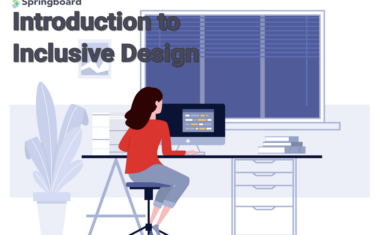Free UX Design Course
Dive into UX design with our free starter course. Transform your creative ideas into user-friendly solutions.
Every day, over 500,000 new websites are created on the Internet. In the last year, accelerated by the pandemic, everyone from small business owners and enterprise leaders to national governments began embracing digital channels to connect with their stakeholders. Digital governance, e-commerce, video conferencing, collaboration, edtech, fintech, etc., are growing exponentially.
In this world that’s rapidly digitizing, a critical differentiator for any software product would be user experience design. For instance, despite products such as Skype and GoToMeeting offering similar features, Zoom saw exponential worldwide adoption, primarily because it was easy to use for even the most tech-unsavvy user. So it is no surprise that in 2021 and beyond, UI/UX designers are in great demand—LinkedIn lists the role among the top 15 jobs on the rise.
There are over 11,000 UX designer positions available today across leading organizations such as Microsoft, Google, MathWorks, JP Morgan Chase, etc. Yet, like most technology-related fields, the number of available opportunities far outweighs the qualified candidates in the market. UX design bootcamps help bridge this demand-supply gap.
In this blog, we will discuss:
- What are UI/UX bootcamps?
- How to choose the right UI/UX bootcamp
- How to make the most of a UI/UX bootcamp
What Is a UI/UX Bootcamp?

A bootcamp in UI/UX design is a short, intensive, practice-oriented learning program focused on giving you the foundation, skills, and tools you need for a successful UX design career. A typical bootcamp:
- Is 6-9 months long
- Requires about 15-20 hours a week
- Can be taken up part-time alongside a full-time job or a college degree
Most bootcamps today are online courses that can be completed from the comfort of your home.
Why Do Designers Choose UI/UX Bootcamps?

Today, aspiring designers prefer bootcamps over traditional college degrees or on-the-job learning for two primary reasons: Speed and value. A traditional college degree can take four years before you can get a job and tuition is extremely high. On the other hand, without a strong foundation, learning on the job might waste more time making unnecessary mistakes, further delaying growth.
A bootcamp addresses both these concerns. Unlike a college degree, you will be job-ready in 6-9 months. Bootcamps offer a solid foundation of skills that can be applied to practice immediately. They cost only a fraction of the traditional college fee, many of them offering payment plans and a job guarantee.
Related Read: What Does a UX Designer Do?
Get To Know Other Design Students
Rachel Millman
Product Designer at Bonterra
Bibi Tanjasiri
Product Designer at Hatch
Valena Del Valle
Junior Product Designer at The Hartford
What To Look For in a UI/UX Design Bootcamp
The primary goal of a UI/UX design bootcamp is to facilitate your transition to a career in the field. To set you up for success in the job market, a bootcamp needs to offer:
1. Industry-focused curriculum

UX concepts, processes, and styles are evolving rapidly. For instance, ‘user personas’ were the primary UX research tool for understanding users for years. Recently, several designers are adopting the Jobs To Be Done (JTBD) framework as an alternative to user personas. Similarly, the classic computer design trend, skeuomorphism, saw a revival in the form of neumorphism in 2020.
Therefore, a good UI/UX bootcamp must have a curriculum that accommodates the latest in human-computer interaction. While evaluating the curriculum of a UI/UX bootcamp, look at:
The curriculum designers and instructors. A bootcamp needs to be created and taught by industry professionals, not just academicians. It must offer resources that can be used throughout your UX career.
How often it’s updated. If the last update was several years ago, you might want to look elsewhere.
Whether it is comprehensive. It must cover the breadth of UI/UX design skills, including design thinking, user research, web design, information architecture, user interface design, visual design, interaction design, wireframes, prototypes, etc.
How broad-based or in-depth the modules are. While learning any skill, you need both a clear foundational understanding and an in-depth view of some key areas. A good bootcamp must offer you both.
2. Hands-on learning

As a practical skill, your UI/UX design training is only as good as your ability to apply it to real-world problems. So, a good UI/UX bootcamp must offer:
- Real-world experience in UX design
- A capstone project that demonstrates your ability to apply your UX skills to business scenarios
- An opportunity to build a UI/UX design portfolio that covers end-to-end design skills
- Collaborations with industry experts or organizations
- Behavioral skills to receive and work on stakeholder feedback
- Mini-projects in specialized areas of interest such as research, UI design, usability testing, etc.
3. 1:1 mentorship from an industry expert

You might learn the skills and even have a portfolio, but transitioning to a career in the field of user experience is a whole new game altogether. For learners with no background in design, navigating the field can be challenging. It is this problem that good UI/UX bootcamps solve through personalized mentorships.
While evaluating bootcamps in UI/UX design, check whether it offers you access to mentors who are leading UX professionals themselves. Also ask:
- How many calls can you have with the mentor?
- How often can you connect with the mentor?
- What are the mentors willing to help you with?
- Will they be happy to give you industry exposure and introduce you to their network?
4. Career coaching

You might have the UX skills to do the work but are not yet equipped to get the job. For instance, despite having the skills and the experience, several candidates struggle in their job search because they do not have the right resume or get nervous during interviews. To overcome these hurdles and help you kickstart your UX career, the UI/UX bootcamp must also offer comprehensive career coaching.
Your coach must help you:
- Develop a job search strategy
- Create a resume that will land you interviews
- Ace the interview with confidence
- Negotiate salary
- Transition into your UX job confidently
Can a UX Design Bootcamp Get You a Job?
We say, yes of course! Several of Springboard’s learners have landed high-paying jobs in UX design. We are so confident of our program’s ability to find you a job that we offer a job guarantee, where if you don’t get a job after completion, you’ll receive a full refund.
Since you’re here
If you want to work in design, you can. It’s that simple. With our UX Bootcamp, we’ll help you launch your design career in 9 months or less. Browse our free UX salary guide to see what you could be making






